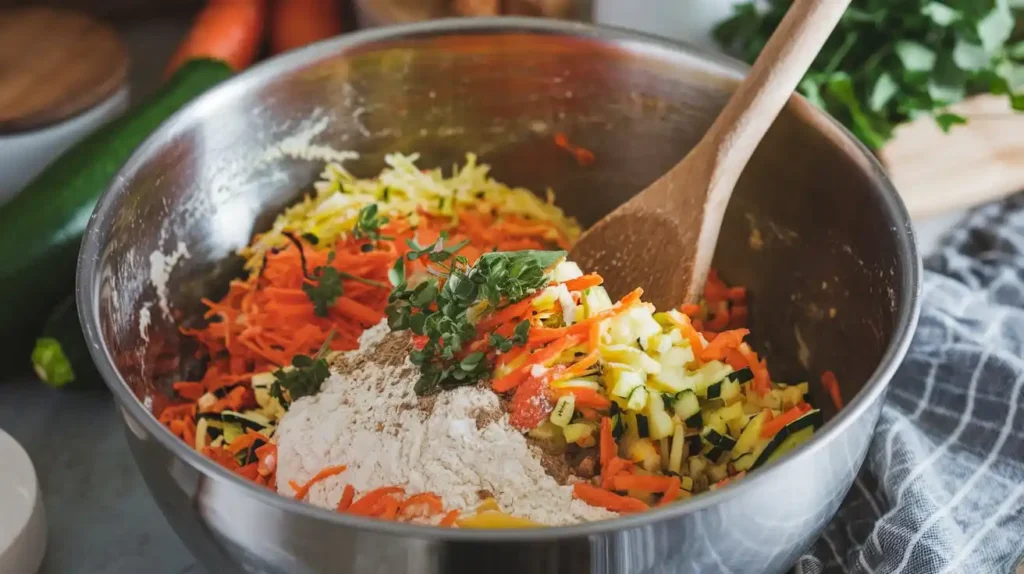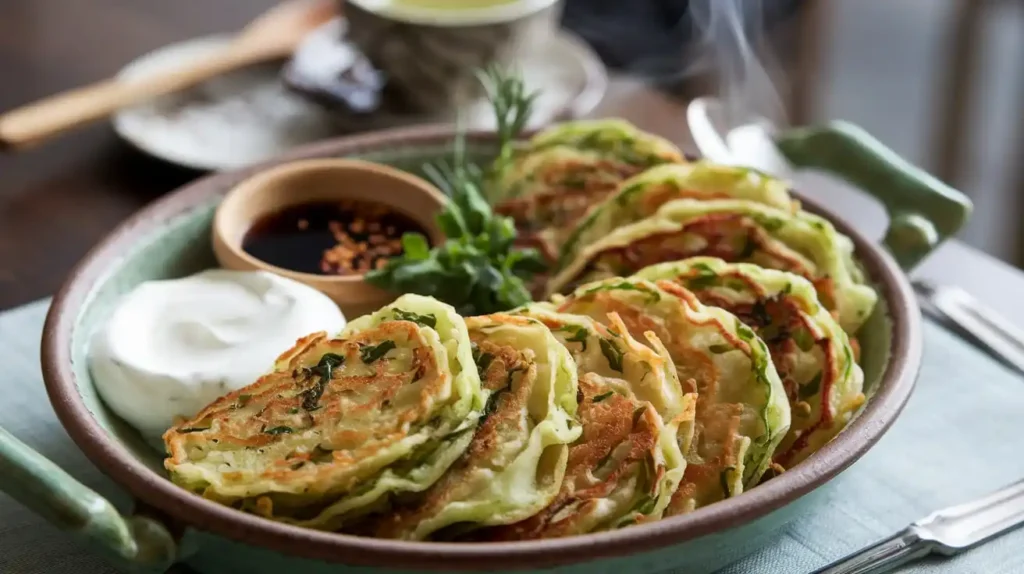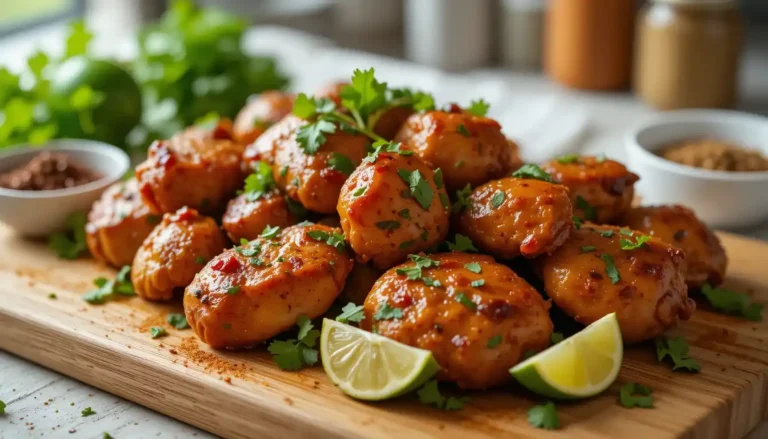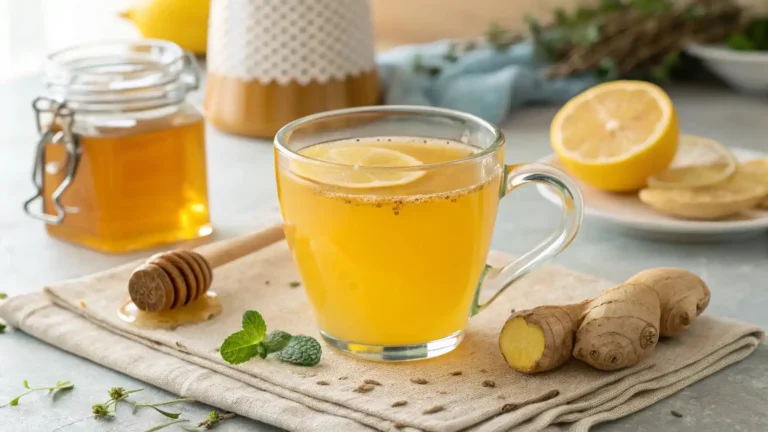Vegetable Pancake Crispy on the outside, soft on the inside, and packed with fresh veggies—Vegetable Pancakes bring together flavor, texture, and nutrition in every bite. Whether you need a quick breakfast, a light lunch, or a satisfying snack, these savory pancakes deliver.
From Korean Pajeon to Indian Besan Chilla, different cultures offer unique variations of Vegetable Pancakes. However, they all follow the same idea—turning simple ingredients into a wholesome, flavorful dish.
In this guide, you’ll learn everything about making the perfect Vegetable Pancake. First, we’ll explore the best ingredients. Then, we’ll walk through step-by-step cooking instructions, regional variations, and expert tips for a crispy, tender texture. Additionally, we’ll cover health benefits, common mistakes to avoid, and the best dipping sauces to elevate the experience.
So, let’s jump in and discover the magic of Vegetable Pancakes!
Table of contents
- What Is a Vegetable Pancake?
- Key Ingredients for the Perfect Vegetable Pancake
- Step-by-Step Recipe for a Classic Vegetable Pancake
- Variations of Vegetable Pancakes from Around the World
- Health Benefits of Vegetable Pancakes
- Common Mistakes and How to Avoid Them
- Pairing Vegetable Pancakes with the Best Dips and Sauces
- Storing and Preserving Freshness
- Frequently Asked Questions
- Enjoy the Perfect Vegetable Pancake Anytime!
What Is a Vegetable Pancake?
The Origin of Vegetable Pancakes
Although pancakes are often sweet, many cultures have enjoyed savory Vegetable Pancakes for centuries. For example, Korea’s Pajeon combines scallions, vegetables, and a light, crispy batter. It pairs perfectly with a savory soy dipping sauce. Meanwhile, India’s Besan Chilla features chickpea flour, warm spices, and fresh herbs, making it both gluten-free and flavorful.
Across Europe and North America, vegetable pancakes take a different form. Many versions use grated zucchini, carrots, or potatoes. Some recipes even include cheese and herbs for extra richness. Regardless of the style, these pancakes always deliver a crispy, hearty bite.
Why Are Vegetable Pancakes So Popular?
More people are making Vegetable Pancakes, and it’s easy to see why:
- Packed with nutrients – They provide fiber, vitamins, and antioxidants.
- Easy to customize – Whether you follow a vegan, gluten-free, or high-protein diet, you can adjust the recipe.
- Quick and budget-friendly – With just a few simple ingredients, you can whip up a batch in no time.
- Great for meal prep – Cook them in advance, store them, and reheat when needed.
How to Enjoy Vegetable Pancakes Any Time of Day
One of the best things about Vegetable Pancakes is their versatility. You can eat them at any time of the day and pair them with different sides and toppings. Here are some tasty serving ideas:
- Breakfast: Top with Greek yogurt or a poached egg.
- Lunch: Serve with a fresh salad for a light, refreshing meal.
- Snack: Dip in spicy sriracha mayo or garlic yogurt.
- Dinner: Pair with grilled meats, tofu, or a warm soup.
Since they’re so easy to customize, you can mix and match vegetables, spices, and flours to create a pancake that perfectly suits your taste.
Key Ingredients for the Perfect Vegetable Pancake
Choosing the Right Vegetables
The secret to a delicious Vegetable Pancake lies in selecting the right combination of vegetables. Since some veggies hold more moisture than others, balancing them correctly ensures the ideal texture.

The Ultimate Guide to Vegetable Pancakes – Crispy, Healthy & Delicious
Ingredients
- 1 cup grated zucchini squeeze out excess water
- 1/2 cup grated carrots
- 1/4 cup chopped scallions
- 1/4 cup finely chopped bell pepper
- 1/2 cup all-purpose flour or whole wheat flour
- 1/4 cup cornstarch for extra crispiness
- 1 egg or flax egg for vegan option
- 1/2 teaspoon salt
- 1/4 teaspoon black pepper
- 1/2 teaspoon garlic powder
- 1/2 teaspoon paprika
- 1/2 teaspoon baking powder
- 1/3 cup water adjust as needed
- 2 tablespoons olive oil for frying
Instructions
- In a large bowl, mix together grated zucchini, carrots, scallions, and bell pepper.
- Add flour, cornstarch, salt, pepper, garlic powder, paprika, and baking powder. Stir to combine.
- Add the egg and water, mixing until a thick batter forms. If too thick, add a little more water.
- Heat olive oil in a pan over medium heat. Scoop small portions of batter and flatten into pancakes.
- Cook for 3-4 minutes per side until golden brown and crispy.
- Drain on paper towels and serve warm with yogurt, sour cream, or a dipping sauce.
Notes
Here are some excellent vegetable choices:
- Zucchini and carrots – Add natural sweetness, vibrant color, and a soft bite.
- Bell peppers – Provide a mild crunch and enhance the visual appeal.
- Cabbage – Creates a tender, chewy texture while adding fiber.
- Spinach or kale – Boosts nutrients without overpowering the flavor.
- Green onions – Elevate the savory taste and add a subtle sharpness.
If using high-water-content vegetables like zucchini, always squeeze out excess moisture before mixing. This simple step prevents the batter from becoming too runny.
The Best Flour and Binders for a Perfect Texture
Achieving a crispy yet tender texture depends on the type of flour and binder used. Depending on your dietary needs, you can choose from several options.
- All-purpose flour – The classic choice, offering structure and softness.
- Chickpea flour (besan) – A protein-packed, gluten-free alternative with a slightly nutty flavor.
- Rice flour – Ideal for creating a crispier texture.
- Oat flour – Adds fiber and a mild, wholesome taste.
Since eggs work best as a binder, they are commonly used. However, if you prefer a vegan alternative, try one of these options:
- Flaxseed egg (1 tbsp ground flaxseed + 3 tbsp water, mixed and left to thicken)
- Cornstarch mixed with water for extra crispiness
- Mashed potatoes for a softer, heartier texture
Spices and Seasonings for Extra Flavor
Seasonings can completely transform the taste of your Vegetable Pancake. To make sure your pancakes are packed with flavor, consider these spices:
- Salt and black pepper – The foundation of any great seasoning mix.
- Garlic powder and onion powder – Enhance depth and aroma.
- Turmeric and paprika – Bring warmth, color, and an earthy richness.
- Cumin or coriander – Add a slightly smoky, nutty element.
For an extra burst of freshness, mix in chopped parsley, cilantro, or basil. These herbs not only enhance flavor but also make the pancakes look more vibrant.
Step-by-Step Recipe for a Classic Vegetable Pancake

Ingredients You’ll Need
Before you begin, gather these ingredients:
- 1 cup mixed vegetables (such as zucchini, carrots, bell peppers, or cabbage)
- ½ cup flour (all-purpose, chickpea, or rice flour)
- 1 egg (or flaxseed egg for a vegan version)
- ½ tsp salt
- ½ tsp black pepper
- ¼ tsp garlic powder
- ½ tsp turmeric or paprika
- ½ cup water or milk
- 1 tbsp oil (for frying)
Step 1: Preparing the Vegetables
Start by washing and finely chopping or grating the vegetables. If using zucchini, squeeze out any excess water to maintain the right batter consistency. Next, place all the veggies into a large mixing bowl.
Step 2: Mixing the Batter
Now, add flour, salt, pepper, and spices to the bowl. Stir everything together so the vegetables are evenly coated. Crack an egg (or add the flaxseed mixture) into the bowl and mix well. While stirring, gradually pour in water or milk until the batter reaches a thick yet spreadable consistency.
Step 3: Cooking the Pancakes to Perfection
At this point, it’s time to cook! First, heat a non-stick pan over medium heat and drizzle a little oil. Once hot, pour a ladleful of batter into the pan and spread it into a circular shape. Let it cook for 2–3 minutes per side, flipping once the edges turn golden brown. Repeat the process until all the batter is used.
Step 4: Serving and Garnishing Tips
Once cooked, transfer the pancakes to a plate lined with paper towels to absorb any excess oil. To serve, pair them with yogurt, sour cream, or a flavorful dipping sauce. Finally, garnish with fresh herbs or sesame seeds for an extra touch of flavor.
Variations of Vegetable Pancakes from Around the World
Korean Pajeon – A Crispy, Savory Classic
One of the most popular versions of Vegetable Pancake comes from Korea. Known as Pajeon, this pancake is loaded with scallions, carrots, zucchini, and sometimes seafood, creating a crispy and chewy texture.
How to Make Korean Pajeon
- Mix the batter – Combine all-purpose flour, rice flour, salt, and water to form a light batter.
- Add vegetables – Slice scallions into long strips and mix them with julienned carrots and zucchini.
- Pan-fry until crispy – Pour the batter into a hot, oiled pan, pressing it down to create an even layer. Flip once golden brown.
- Serve with dipping sauce – Pajeon pairs perfectly with a soy sauce-based dipping sauce, enhanced with vinegar and sesame oil.
Indian Besan Chilla – A Spiced, Protein-Packed Delight
Besan Chilla, an Indian-style Vegetable Pancake, is naturally gluten-free and made with chickpea flour (besan). It’s rich in protein and flavor, making it a nutritious meal or snack.
How to Make Besan Chilla
- Prepare the batter – Mix chickpea flour, turmeric, cumin, salt, and water into a smooth, thick batter.
- Add veggies – Stir in finely chopped onions, tomatoes, and green chilies.
- Cook until golden brown – Pour batter onto a hot, lightly oiled pan, spreading it evenly. Flip once firm.
- Serve with chutney – Enjoy with mint or coriander chutney for an authentic Indian touch.
Western-Style Savory Pancakes – A Versatile Option
In Western cuisine, Vegetable Pancakes often feature zucchini, carrots, and potatoes, sometimes paired with cheese and herbs for extra richness.
To make them:
- Grate and drain zucchini or potatoes to remove excess water.
- Mix with eggs, flour, cheese, and seasonings for a well-balanced batter.
- Pan-fry in oil until golden brown and crispy.
Gluten-Free & Vegan Vegetable Pancakes
For a gluten-free or vegan option, use chickpea flour, rice flour, or almond flour instead of wheat flour. Instead of eggs, try flax eggs, mashed potatoes, or a cornstarch-water mixture for binding.
Health Benefits of Vegetable Pancakes
Packed with Nutrients and Fiber
Eating Vegetable Pancakes is an easy and tasty way to increase your intake of vitamins and fiber. Since these pancakes feature fresh veggies like zucchini, carrots, spinach, and bell peppers, they provide:
- Vitamin A and C – Important for immunity and skin health.
- Iron and Folate – Essential for blood circulation and energy.
- Dietary Fiber – Supports digestion and gut health.
A Healthier Alternative to Traditional Pancakes
Unlike sweet pancakes made with refined flour and sugar, Vegetable Pancakes offer a lower-carb, nutrient-dense alternative. Many recipes use whole-grain or gluten-free flours, making them even healthier.
For a low-calorie version, consider:
- Using less oil or cooking on a non-stick pan.
- Swapping white flour for chickpea or oat flour to add protein.
- Increasing green vegetables like spinach or kale for extra nutrients.
Weight-Loss and Diet-Friendly Options
If you’re trying to lose weight or eat healthier, Vegetable Pancakes can be a great option. Because they are high in fiber and protein, they help keep you full longer, reducing cravings.
To make them even more diet-friendly:
- Reduce flour and use more veggies to lower calories.
- Bake instead of frying to cut down on oil.
- Pair with a light yogurt dip instead of heavy sauces.
With just a few simple tweaks, Vegetable Pancakes can fit into any healthy eating plan.
Common Mistakes and How to Avoid Them
Even though making a Vegetable Pancake is simple, a few common mistakes can ruin the texture and flavor. To help you get perfect results every time, let’s go over some of these pitfalls and how to fix them.
Why Do My Pancakes Fall Apart?
One of the most frustrating issues when making Vegetable Pancakes is when they break apart while cooking. This usually happens for a few reasons:
- Not enough binder – Eggs help hold everything together. If making a vegan version, use flax eggs or cornstarch mixed with water.
- Too many watery vegetables – Zucchini, for example, releases a lot of moisture. Always squeeze out excess water before mixing into the batter.
- The batter is too dry – If the mixture doesn’t hold together well, add a small amount of water or milk until it becomes slightly sticky.
How to Make Pancakes Crispy Instead of Soggy
A great Vegetable Pancake should have a crispy exterior with a tender inside. If your pancakes turn out too soft or greasy, here’s what might be wrong:
- Too much oil – Use only a thin layer of oil in the pan. Adding too much can make the pancakes greasy.
- Pan is not hot enough – Always preheat the pan to medium-high heat before adding the batter. This ensures a crispier surface.
- Batter is too wet – If there is too much liquid in the batter, add a little more flour to absorb moisture.
Preventing Pancakes from Sticking to the Pan
If your Vegetable Pancake sticks to the pan, it can break apart when flipping. To prevent this:
- Use a non-stick or well-seasoned pan for best results.
- Preheat the pan and oil properly before adding the batter.
- Don’t flip too early—wait until the edges turn golden brown.
By avoiding these mistakes, you’ll achieve crispy, golden-brown pancakes every time!
Pairing Vegetable Pancakes with the Best Dips and Sauces

Pairing your Vegetable Pancake with a delicious dip or sauce can take the flavors to the next level. Whether you prefer a spicy kick, a creamy contrast, or a tangy twist, there’s a perfect sauce for everyone.
Classic Sauces from Different Cultures
Different regions serve Vegetable Pancakes with unique and flavorful sauces. Here are some traditional pairings:
- Soy Sauce & Vinegar (Korean Pajeon) – A mix of soy sauce, vinegar, sesame oil, and red pepper flakes gives a salty, tangy, and slightly spicy taste.
- Spiced Yogurt & Mint Chutney (Indian Besan Chilla) – A creamy yogurt dip or a refreshing mint chutney adds a cooling contrast to the warm spices in the pancake.
- Garlic Aioli & Sour Cream (Western-Style Pancakes) – A smooth garlic aioli or tangy sour cream pairs well with crispy pancakes, enhancing their rich, savory flavor.
Homemade Dips You Can Try
If you want to experiment with flavors, try these quick and easy homemade dips:
- Spicy Sriracha Mayo – Mix 2 tbsp mayonnaise with 1 tsp sriracha for a creamy, spicy dip.
- Lemon-Herb Yogurt Sauce – Combine Greek yogurt, lemon juice, garlic, and fresh herbs for a refreshing topping.
- Tahini Garlic Dip – Blend tahini, lemon juice, garlic, and water for a nutty, slightly tangy sauce.
Choosing the Best Beverage Pairing
In addition to dips, choosing the right drink can enhance the experience. Try serving your Vegetable Pancakes with:
- Green tea for a light and refreshing balance.
- Freshly squeezed lemonade for a citrusy contrast.
- Iced coffee or chai latte for a cozy, flavorful pairing.
With the right dip and drink, your Vegetable Pancake becomes an even more satisfying dish!
Storing and Preserving Freshness
Vegetable Pancakes taste best when freshly made, but you can store leftovers for later without losing flavor or texture. Proper storage ensures they remain crispy on the outside and soft on the inside.
Best Ways to Store Freshly Made Pancakes
If you plan to eat your Vegetable Pancakes within a few days, storing them in the fridge is the best option. Follow these steps:
- Let them cool completely – Storing warm pancakes traps steam, making them soggy.
- Layer with parchment paper – Stack pancakes with parchment paper in between to prevent sticking.
- Use an airtight container – This keeps moisture out and maintains freshness.
- Refrigerate for up to 3 days – Beyond that, they may lose their crispiness.
Can You Freeze Vegetable Pancakes?
Yes! Freezing is a great way to extend the shelf life of Vegetable Pancakes. Here’s how to do it properly:
- Cool the pancakes before freezing to prevent excess moisture buildup.
- Arrange them in a single layer on a baking sheet and freeze for one hour.
- Transfer to a freezer-safe bag or container, squeezing out excess air.
- Label and date the container to keep track of freshness.
- Freeze for up to 2 months – For the best taste, eat them within this time frame.
Reheating for the Best Taste and Texture
To enjoy your pancakes as if they were freshly made, choose the right reheating method:
- Oven (Best for crispiness) – Preheat to 350°F (175°C) and heat pancakes for 10 minutes.
- Pan-frying (Quick & crispy) – Heat a pan with a little oil and reheat for 2-3 minutes per side.
- Microwave (Fastest option) – Heat on medium power for 30–40 seconds, but this may soften the texture.
By following these simple storage and reheating methods, you can enjoy your Vegetable Pancakes anytime!
Frequently Asked Questions
Many people have questions about making, storing, and customizing Vegetable Pancakes. Below are answers to some of the most commonly asked questions.
1. Can I Make Vegetable Pancakes Without Eggs?
Yes! If you’re avoiding eggs, you can use these vegan-friendly alternatives:
- Flaxseed egg (1 tbsp ground flaxseed + 3 tbsp water, mixed and left to thicken).
- Cornstarch mixed with water for binding.
- Mashed potatoes to hold everything together.
These options keep your pancakes firm without affecting flavor.
2. What Vegetables Work Best in Vegetable Pancakes?
The best vegetables for Vegetable Pancakes are those that provide texture and flavor. Some great choices include:
- Zucchini (moist and soft, but squeeze out excess water).
- Carrots (adds sweetness and color).
- Cabbage (helps with a chewy bite).
- Spinach or kale (boosts nutrients).
- Bell peppers (adds crunch and vibrancy).
You can mix and match based on your preference.
3. Are Vegetable Pancakes Good for Weight Loss?
Yes! Vegetable Pancakes can be a low-calorie, high-fiber meal, keeping you full longer. To make them even healthier:
- Use less oil or bake instead of frying.
- Swap white flour for chickpea or oat flour to add more protein.
- Load up on veggies to increase fiber content.
Pairing them with a light yogurt dip or salad makes them even more weight-loss friendly.
4. How Do You Make Vegetable Pancakes Extra Crispy?
To achieve a crispy pancake, follow these tips:
- Use rice flour or cornstarch in the batter for extra crunch.
- Preheat the pan properly before adding the batter.
- Cook on medium-high heat to get golden brown edges.
- Use a thin layer of oil instead of too much, which can make them greasy.
With these tricks, your Vegetable Pancakes will always turn out crispy and delicious!
Enjoy the Perfect Vegetable Pancake Anytime!
Vegetable Pancakes are more than just a delicious meal—they’re a versatile, nutritious, and easy-to-make dish that can be enjoyed any time of day. Whether you prefer the crispy Korean Pajeon, the protein-packed Indian Besan Chilla, or a classic Western-style pancake, there’s a version for everyone.
By selecting the right vegetables, flours, and seasonings, you can customize your Vegetable Pancake to fit your taste and dietary needs. Plus, with proper storage and reheating methods, you can enjoy them fresh, even on busy days.
Final Tips for the Best Vegetable Pancakes:
Use the right binder – Eggs, flax eggs, or mashed potatoes help hold everything together.
Control moisture levels – Always squeeze out excess water from veggies like zucchini.
Cook at the right heat – Medium-high heat ensures a crispy exterior and a tender inside.
Pair with delicious dips – Soy sauce, yogurt, or spicy chutneys enhance the flavor.
Experiment with variations – Try gluten-free, vegan, or high-protein options for a new twist.
Creative Ways to Serve Vegetable Pancakes:
🥞 Breakfast: Top with a fried egg and a dollop of Greek yogurt.
🥗 Lunch: Pair with a fresh green salad for a light, balanced meal.
🍽 Dinner: Serve with grilled chicken, tofu, or a warm bowl of soup.
🧑🍳 Snack: Enjoy with a spicy sriracha mayo or tangy garlic aioli.
Now that you know everything about making the perfect Vegetable Pancake, it’s time to grab your ingredients and start cooking! Which variation will you try first? Let us know in the comments and happy cooking! 😊🥞✨
If you’re looking for even more inspiration, visit Foodful Recipes to discover other tasty meal ideas!

Vegetable Pancakes
Equipment
- Mixing Bowl
- Pan
- Grater
- Spoon
Ingredients
- 1 cup Zucchini grated, squeeze out excess water
- 1/2 cup Carrots grated
- 1/4 cup Scallions chopped
- 1/4 cup Bell Pepper chopped
- 1/2 cup All-purpose Flour
- 1/4 cup Cornstarch for extra crispiness
- 1 large Egg or flax egg for vegan version
- 1/2 tsp Salt
- 1/4 tsp Black Pepper
- 1/2 tsp Garlic Powder
- 1/2 tsp Paprika
- 1/2 tsp Baking Powder
- 1/3 cup Water adjust as needed
- 2 tbsp Olive Oil for frying
Instructions
- In a large mixing bowl, combine the grated zucchini, carrots, chopped scallions, and bell pepper.
- In a separate bowl, mix together the flour, cornstarch, salt, pepper, garlic powder, paprika, and baking powder.
- Add the dry ingredients to the vegetable mixture, followed by the egg (or flax egg for vegan). Gradually add water until the batter reaches a thick but spreadable consistency.
- Heat olive oil in a pan over medium heat. Scoop portions of the batter onto the pan and flatten slightly to form pancakes.
- Cook for 3-4 minutes per side, until golden brown and crispy. Transfer to a paper towel-lined plate to absorb excess oil.
- Serve warm with a dipping sauce of your choice, such as spicy sriracha mayo or garlic yogurt.





